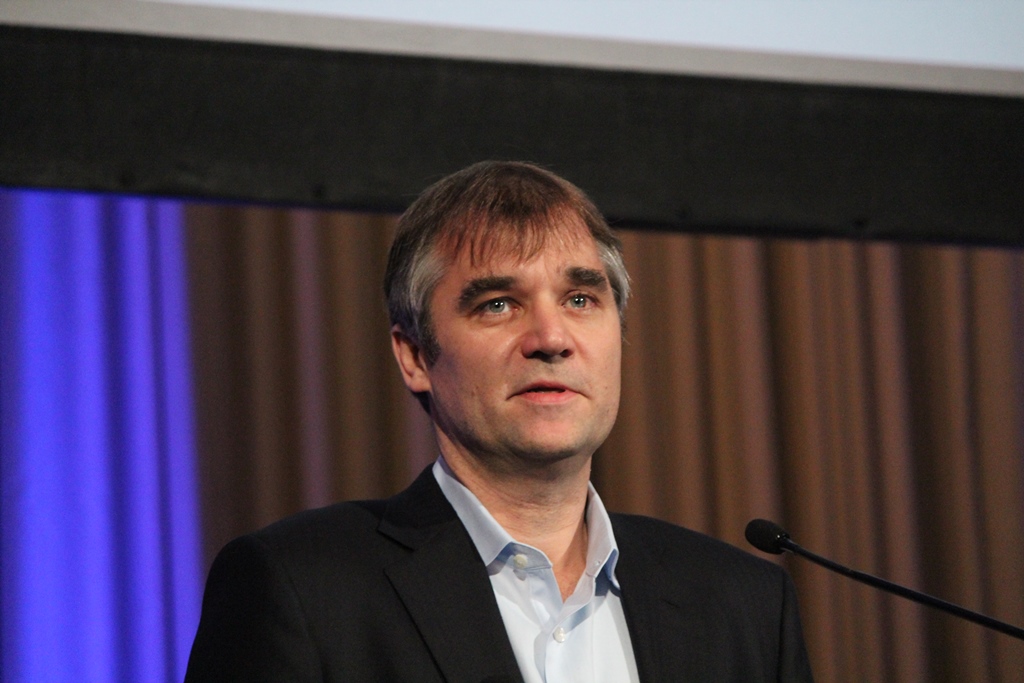SMPTE Conference Draws Large Crowds

Barabara Lange
HOLLYWOOD—SMPTE’s annual Technical Conference and Exhibition officially opened here Tuesday morning to, as the organization’s executive director, Barbara Lange said, “…bring the brightest minds in the business together to learn about the newest technologies and to get on the inside track about how these technologies can impact media businesses.”
This year’s event attracted some 2,000 persons, all intent on learning about the latest developments in the fields of television and cinema. This figure represents a breakaway from declining attendance experienced over the last several years. According to Lange, this year’s registration figure was possibly a record—at least the largest number recorded in the past seven years. She noted that conference participants came from as far away as Vietnam and Turkey, with a total of 24 foreign nations represented at the conference.
In addition to the presentation of papers on hot technological topics, the conference also featured demonstrations of the latest technologies, ranging from very high efficiency video coding to HD display technologies and test and measurement gear for evaluating today’s television signals. A total of 76 exhibitors completely filled the conference exhibition space at Lowe’s Hollywood Hotel hereto capacity. “It was a sellout crowd,” said Lange. “We had to do some squeezing to accommodate everyone who wanted booth space.”
In addition to equipment exhibitions just outside the technical presentation rooms, the event also featured a special Monday pre-conference all-day session on UHD television, with a separate equipment demonstration being set up in a meeting room just off the hotel’s lobby area.
“This was highest concentration of 4K equipment displays in one place ever,” said Lange. The 4K exhibit and demo room remained packed with persons wanting to witness UHD image processing for themselves until its official closing at mid-day Wednesday.
A CHANGING VIDEO CONSUMER EXPERIENCE
While the main focus of the conference was on such emerging technologies as ultra high-defintion television, file-based workflows and IP-based infrastructures, Tuesday morning’s keynote speaker, Thomas Gewecke, chief digital officer and executive vice president for strategy and business development at Warner Bros. Entertainment, examined another aspect of the rapidly evolving video and cinema business—evolving modalities for delivering content to the consumer.

Thomas Gewecke “We see that every aspect of how we find and experience content is changing rapidly,” said Gewecke. “The last five or six years have brought an exponential increase in the pace of change, particularly from the consumer standpoint. The change affects and impacts everything—how content production happens, how distribution works, the core platforms, the basic business models defining this business. This is a fundamental opportunity for us to innovate. It’s a time for us to look at what the consumer is able to do, what the consumer wants. It’s great opportunity to create new product and services and redefine in some ways the traditional products that we have. Improving the consumer experience is the key deliverable.”
Gewecke noted that just five years ago it was rare if someone was viewing content on a connected screen, but today the majority of video displays were connected or connectable.
“This has profound implications,” he said. “When your screen is connected, you’re logged in to something. The television screen potentially knows who you are. It knows your viewing history if you’ve chosen to make that available. This is not just a sort of interesting thing from the consumer’s standpoint; it’s a fundamental revolution in what we can deliver to the screen. It turns that what used to be a one-to-many experience where as a content owner we did not know who was watching our product. Today in principle the technology is there to allow a one-to-one experience, a one-to-one communication between the content owner, the content producer and the consumer who owns the screen.”
Gewecke observed, however, that while such technology was available, product to take advantage of it was not.
“We haven’t yet reinvented the movie or the television show to take advantage of the existence of a connected screen experience,” he said. “The screens, of course, are ubiquitous. The screen is increasingly in our pockets, or carried around as a tablet. It’s in the kitchen in appliances, it’s going to be our windshields—heads-up displays. Soon we’ll be wearing a screen.”
SUPPLY SIDE MUST ALSO CHANGE
Gewecke foresaw that such a revolution could even go further to change the viewer experience and also impact the way entertainment media companies do business.
“How long before wearable connected eyewear becomes a serious mass market medium for studios to think about. It may be shorter than we think. And the pace of change is only going to increase and [it] fundamentally affects how we think about the business. It’s increasingly clear that when we think about making great entertainment and bring it to consumers, we have to be tremendously cognizant of the fact that the experience our consumers are having are changing all the time. The change is measured in months or quarters, not years. Some of the business models we use have been in place for years or decades.”
The SMPTE Technical Conference and Exposition wraps up Thursday evening with its traditional honors and awards banquet and ceremony.
The professional video industry's #1 source for news, trends and product and tech information. Sign up below.
